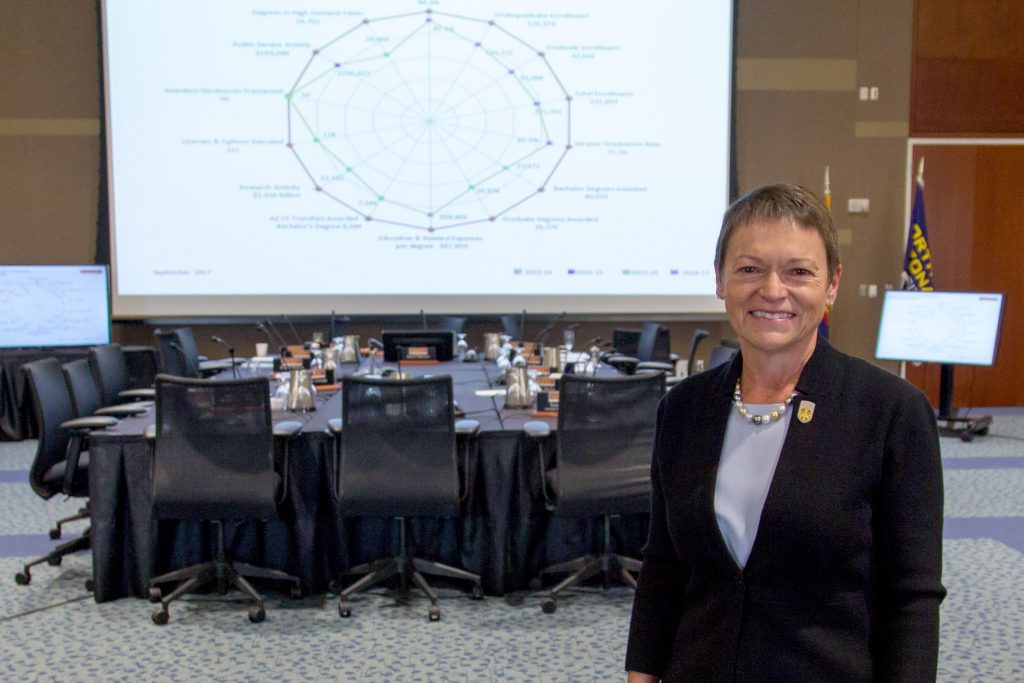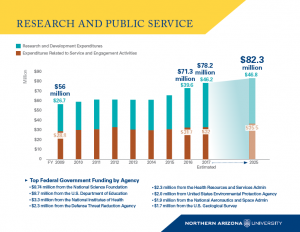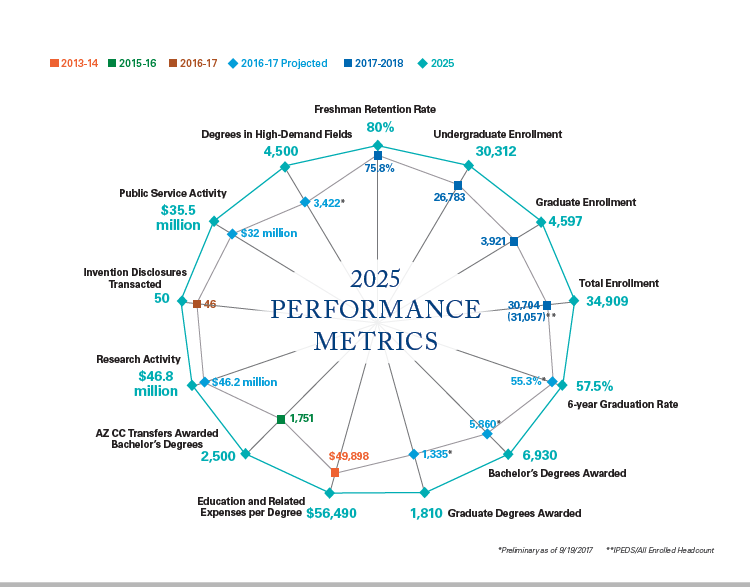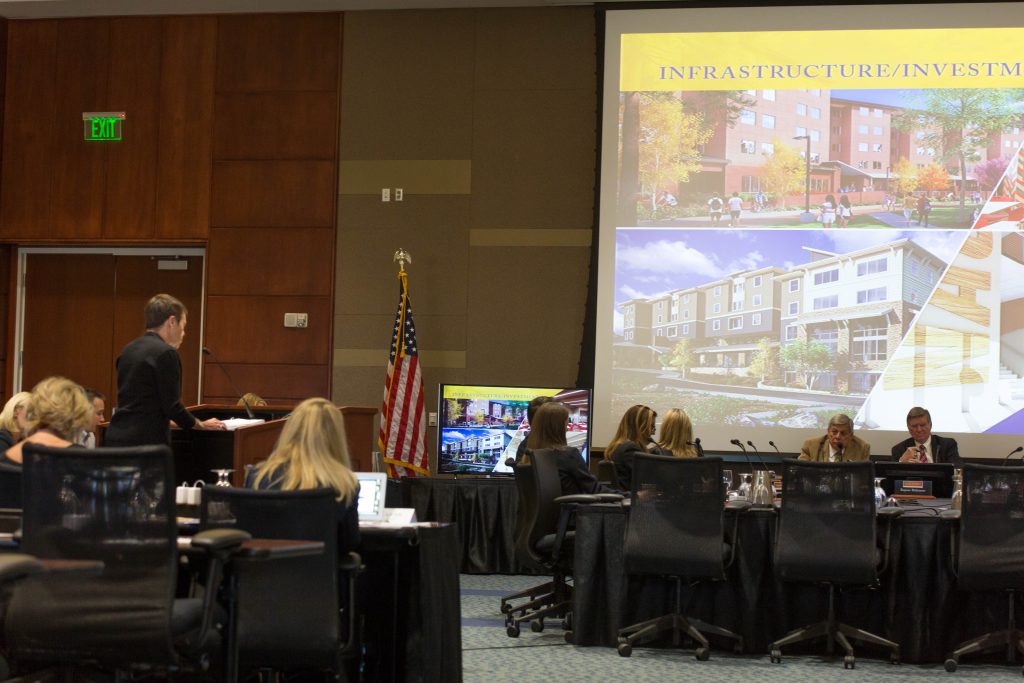
NAU Communications
Northern Arizona University is striving to be at the intersection of what students need to earn a college degree and how to prepare them to enter the workforce, President Rita Cheng told the Arizona Board of Regents at its meeting Friday, Sept. 29, in Flagstaff.
“Intersections lead to more connections between the workforce and those preparing to enter it,” Cheng said. “They allow for stronger ties between art and science, public service and business, and questions and answers. Intersections, to put it simply, strengthen what we do and enhance the scope of what we can do.”
In her presentation to the Board of Regents, she discussed a number of goals and programs, including the announcement of the university’s recent collaboration with the Yavapai County School superintendent and County Education Service Agency to create a Northern Arizona College Resource Center in Prescott Valley, with outreach services beginning later this year.
“Our efforts will provide college access services to Yavapai County students and families, including financial aid awareness and education, workshops and application support, scholarship and one-on-one, personalized, assistance,” she said.
That partnership is the latest example of NAU’s commitment to building programs around student needs, she said—a commitment that requires programs be continually adapted as the needs of students and the industry and world change. That these changes are working is evidenced by the increases in enrollment in the last decade, on the Flagstaff campus and other campuses throughout the state as well as online. Total enrollment this year is more than 31,000, a record for NAU.
NAU is becoming increasingly diverse as more students enroll. Students from 128 Native American tribes attend the university, with the Institute for Tribal Environmental Professionals establishing partnerships with 95 percent of the tribes in the United States, helping to strengthen tribal capacity and sovereignty.
Almost a quarter of NAU’s students identify as Hispanic or Latino. The NAU-Yuma campus has been designated as a Hispanic-serving institution, and the Flagstaff campus is moving in that direction. Additionally, more than 1,300 students from 82 countries have chosen NAU to further their education.
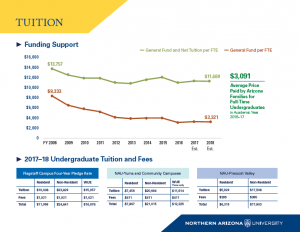
For some, NAU’s affordability is the draw. Cheng pointed to the tuition pledge program, which allows students to pay the same tuition for the four years they are in school and the dropping of more than 200 fees for next year. Every year the university provides more than $100 million in financial aid, with the average Arizona family paying $3,091 every year for full-time undergraduate tuition and fees. In fiscal year 2016, nearly 40 percent of undergraduate students graduated without student debt
For other students, NAU’s commitment to creating a safe and pleasant place to live, work and study is the draw. In addition to new residence halls and dining options, NAU is working with state officials to improve the infrastructure on campus, with frequent upgrades to classroom technology, a new recital hall in the early stages of construction and planned investments in the North Campus Science Corridor, which will provide much-needed additional research space, Cheng said.
For other students, the diverse educational offerings out of Flagstaff is the draw. NAU has 21 locations throughout the state, allowing people to earn NAU degrees in their hometowns, as well as offering a number of degrees online, providing a pathway to a college education for people whose circumstances don’t allow them to have a traditional college experience.
This will continue to be a primary focus for NAU, as the hiring for a dean of online learning begins and improvements in IT and operations allows for a more streamlined experience.
“At NAU, we understand that education is not always a straight road for our students,” Cheng said. “Our programs need us to meet them at the intersection of life and learning.”
She also highlighted the partnerships NAU has with other colleges and universities, governmental entities and businesses, which provide internships and hands-on learning opportunities for students in a variety of disciplines. One example is at NAU-Yavapai in Prescott Valley, which will allow Yavapai College students to transition into NAU’s Hotel and Restaurant Management Program and provide training opportunities, the first of which is at MGM in Las Vegas.
Research continues to be a draw for both students and faculty members, Cheng said. NAU is listed as 219th in the United States in the most recent National Science Foundation rankings, moving the university closer to the goal of being in the top 200 research institutions. In 2016, research expenditures reached $39.6 million and is projected to be $46 million in the next fiscal year.
Cheng also touted the university’s fiscal responsibility, even as the amount of money NAU receives from the state for each student has declined. NAU has a stable bond rating and has exceeded the board’s timeline of end-of-the-year cash on hand.
She thanked ABOR along with state elected officials for prioritizing universities in the state budget this year and said such support is needed to continue for investments in infrastructure and personnel; NAU continues to lag behind the market and peer institutions for faculty and staff salaries, which can make recruiting more difficult.
Cheng also thanked donors and investors in NAU, including the vast alumni network and members of the Flagstaff and Arizona communities who have supported the university and its students.
“Throughout every day, our team works to create a stronger community, a safer and more connected region and a more caring Arizona,” she said.
Watch President Cheng’s presentation to ABOR.
